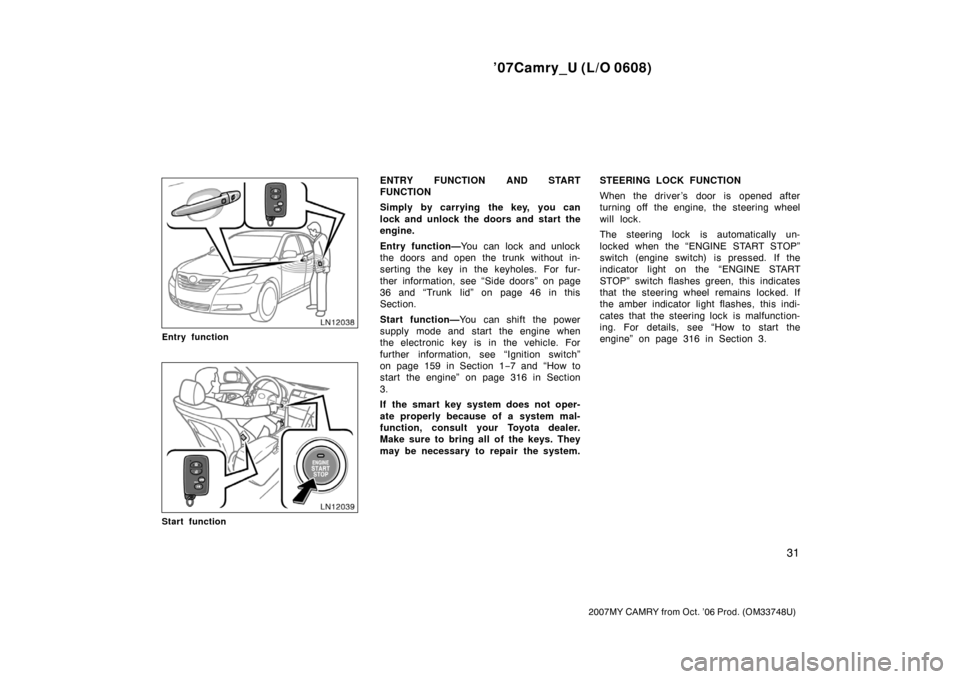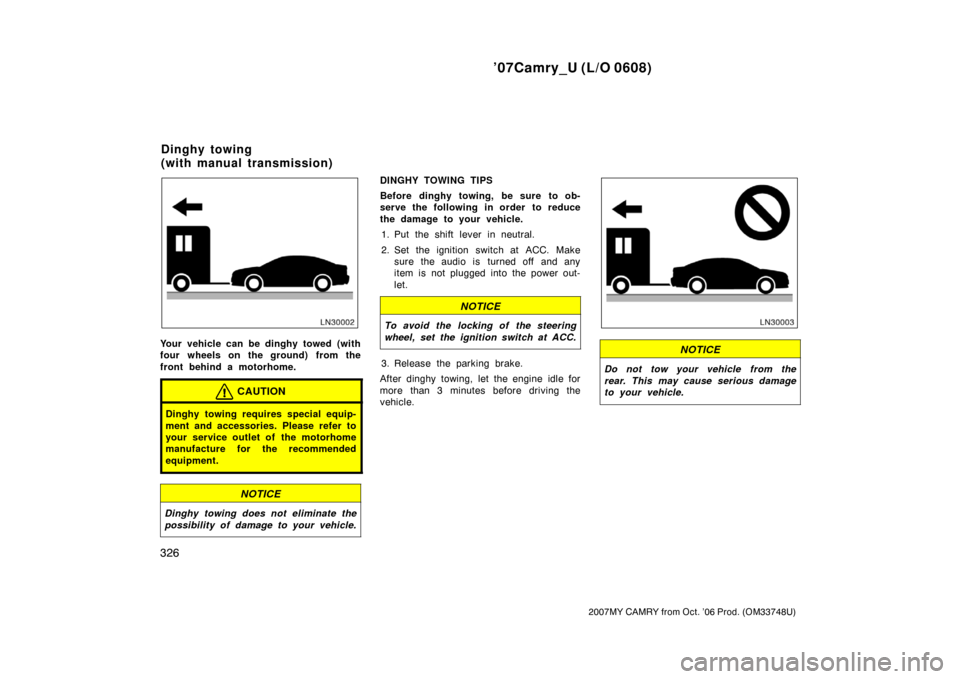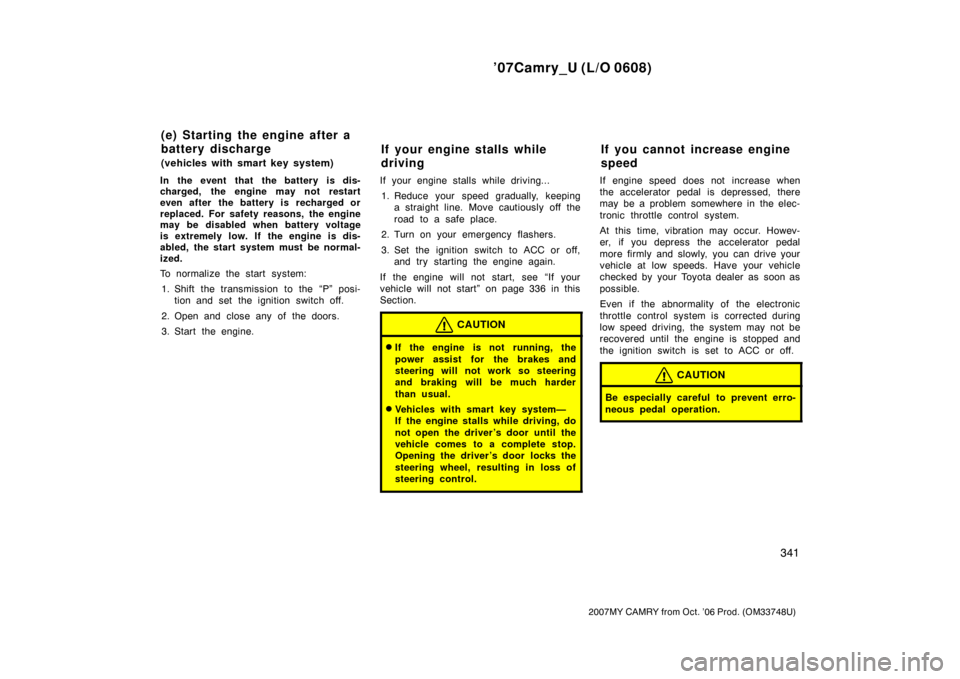Page 10 of 428
’07Camry_U (L/O 0608)
2
2007MY CAMRY from Oct. ’06 Prod. (OM33748U)
1. Side defroster outlets
2. Side vents
3. Instrument cluster
4. Center vents
5. Power door lock switches
6. Power window switches
7. Glove box
8. Cup holder
9. Rear console box
10. Parking brake lever
11. Manual transmission gear shift lever
12. Tilt and telescopic steering wheel lock
release lever
13. Hood lock release lever
14. Window lock switch
Instrument panel overview
�Manual transmission models
Page 11 of 428
’07Camry_U (L/O 0608)
3
2007MY CAMRY from Oct. ’06 Prod. (OM33748U)
1. Side defroster outlets
2. Side vents
3. Instrument cluster
4. Center vents
5. Power door lock switches
6. Power window switches
7. Glove box
8. Cup holder
9. Rear console box
10. Rear vents
11. Auxiliary box and/or power outlet
12. Automatic transmission selector lever
13. Seat heater switches
14. Tilt and telescopic steering wheel lock
release lever
15. Hood lock release lever
16. Parking brake pedal
17. Window lock switch �Automatic transmission models
Page 39 of 428

’07Camry_U (L/O 0608)
31
2007MY CAMRY from Oct. ’06 Prod. (OM33748U)
Entry function
Start function
ENTRY FUNCTION AND START
FUNCTION
Simply by carrying the key, you can
lock and unlock the doors and start the
engine.
Entry function—You can lock and unlock
the doors and open the trunk without in-
serting the key in the keyholes. For fur-
ther information, see “Side doors” on page
36 and “Trunk lid” on page 46 in this
Section.
Start function—You can shift the power
supply mode and start the engine when
the electronic key is in the vehicle. For
further information, see “Ignition switch”
on page 159 in Section 1−7 and “How to
start the engine” on page 316 in Section
3.
If the smart key system does not oper-
ate properly because of a system mal-
function, consult your Toyota dealer.
Make sure to bring all of the keys. They
may be necessary to repair the system.STEERING LOCK FUNCTION
When the driver ’s door is opened after
turning off the engine, the steering wheel
will lock.
The steering lock is automatically un-
locked when the “ENGINE START STOP”
switch (engine switch) is pressed. If the
indicator light on the “ENGINE START
STOP” switch flashes green, this indicates
that the steering wheel remains locked. If
the amber indicator light flashes, this indi-
cates that the steering lock is malfunction-
ing. For details, see “How to start the
engine” on page 316 in Section 3.
Page 91 of 428

’07Camry_U (L/O 0608)
83
2007MY CAMRY from Oct. ’06 Prod. (OM33748U)
This warning light system monitors the
airbag sensor assembly, front airbag sen-
sors, side and curtain shield airbag sen-
sors, curtain shield airbag sensors, driv-
er ’s seat position sensor, driver ’s seat belt
buckle switch, front passenger occupant
classification system, “AIRBAG ON” indi-
cator light, “AIRBAG OFF” indicator light,
front passenger ’s seat belt buckle switch,
seat belt pretensioner assemblies, inflat-
ors, interconnecting wiring and power
sources. (For details, see “Service remind-
er indicators and warning buzzers” on
page 146 in Section 1−6.)
If any of the following conditions occurs,
this indicates a malfunction of the airbags
or seat belt pretensioners. Contact your
Toyota dealer as soon as possible.
�The light does not come on when the
ignition switch is set at ON or remains
on for more than about 6 seconds.
�The light comes on or starts flashing
while driving.
The SRS warning light and “AIRBAG OFF”
indicator light will come on if there is a
malfunction in the front passenger occu-
pant classification system.
In the following cases, contact your Toyota
dealer as soon as possible:
�The SRS front airbags have been in-
flated.
�The front of the vehicle (shaded in the
illustration) was involved in an accident
that was not severe enough to cause
the SRS front airbags to inflate.
�The pad section of the steering wheel
or front passenger airbag cover
(shaded in the illustration) is scratched,
cracked, or otherwise damaged.
NOTICE
Do not disconnect the battery cables
before contacting your Toyota dealer.
Page 315 of 428

’07Camry_U (L/O 0608)
307
2007MY CAMRY from Oct. ’06 Prod. (OM33748U)
Ti r e relat ed ter mMeaning
Accessory weight
the combined weight (in excess of those standard items which may be
replaced) of automatic transmission, power steering, power brakes, power
windows, power seats, radio, and heater, to the extent that these items
are available as factory−installed equipment (whether installed or not)
Cold tire inflation pressure
tire inflation pressure when the vehicle has been parked for at least 3
hours or more, or it has not been driven more than 1.5 km or 1 mile
under that condition
Curb weight
the weight of a motor vehicle with standard equipment including the
maximum capacity of fuel, oil, and coolant, and, if so equipped, air
conditioning and additional weight optional engine
Intended outboard sidewall
(A) the sidewall that contains a whitewall, bears white lettering or bears
manufacturer, brand, and/or model name molding that is higher or
deeper than the same molding on the other sidewall of the tire, or
(B) the outward facing sidewall of an asymmetrical tire that has a particular
side that must always face outward when mounted on a vehicle
Maximum inflation pressurethe maximum cold inflation pressure to which a tire may be inflated and it
is shown on the sidewall of the tire
Maximum loaded vehicle weight
t he sum of —
(a) curb weight;
(b) accessory weight;
(c) vehicle capacity weight; and
(d) production options weight
—Glossary of tire terminology
Page 334 of 428

’07Camry_U (L/O 0608)
326
2007MY CAMRY from Oct. ’06 Prod. (OM33748U)
Your vehicle can be dinghy towed (with
four wheels on the ground) from the
front behind a motorhome.
CAUTION
Dinghy towing requires special equip-
ment and accessories. Please refer to
your service outlet of the motorhome
manufacture for the recommended
equipment.
NOTICE
Dinghy towing does not eliminate the
possibility of damage to your vehicle.
DINGHY TOWING TIPS
Before dinghy towing, be sure to ob-
serve the following in order to reduce
the damage to your vehicle.
1. Put the shift lever in neutral.
2. Set the ignition switch at ACC. Make
sure the audio is turned off and any
item is not plugged into the power out-
let.
NOTICE
To avoid the locking of the steering
wheel, set the ignition switch at ACC.
3. Release the parking brake.
After dinghy towing, let the engine idle for
more than 3 minutes before driving the
vehicle.
NOTICE
Do not tow your vehicle from the
rear. This may cause serious damage
to your vehicle.
Dinghy towing
(with manual transmission)
Page 341 of 428

’07Camry_U (L/O 0608)
333
2007MY CAMRY from Oct. ’06 Prod. (OM33748U)
�Keep the front wheels in proper
alignment. Avoid hitting the curb and
slow down on rough roads. Improper
alignment not only causes faster tire
wear but also puts an extra load on
the engine, which, in turn, wastes fuel.
�Keep the bottom of your vehicle free
from mud, etc. This not only lessens
weight but also helps prevent corro-
sion.
�Keep your vehicle tuned�up and in
top shape. A dirty air cleaner, improp-
er valve clearance, dirty plugs, dirty oil
and grease, brakes not adjusted, etc.
all lower engine performance and con-
tribute to poor fuel economy. For longer
life of all parts and lower operating
costs, keep all maintenance work on
schedule, and if you often drive under
severe conditions, see that your vehicle
receives more frequent maintenance.
(For scheduled maintenance informa-
tion, please refer to the “Scheduled
Maintenance Guide” or “Owner ’s Manu-
al Supplement”.)
CAUTION
Never turn off the engine to coast
down hills. Your power steering and
brake booster will not function with-
out the engine running. Also, the
emission control system operates
properly only when the engine is run-
ning.
Page 349 of 428

’07Camry_U (L/O 0608)
341
2007MY CAMRY from Oct. ’06 Prod. (OM33748U)
In the event that the battery is dis-
charged, the engine may not restart
even after the battery is recharged or
replaced. For safety reasons, the engine
may be disabled when battery voltage
is extremely low. If the engine is dis-
abled, the start system must be normal-
ized.
To normalize the start system:
1. Shift the transmission to the “P” posi-
tion and set the ignition switch off.
2. Open and close any of the doors.
3. Start the engine.If your engine stalls while driving...
1. Reduce your speed gradually, keeping
a straight line. Move cautiously off the
road to a safe place.
2. Turn on your emergency flashers.
3. Set the ignition switch to ACC or off,
and try starting the engine again.
If the engine will not start, see “If your
vehicle will not start” on page 336 in this
Section.
CAUTION
�If the engine is not running, the
power assist for the brakes and
steering will not work so steering
and braking will be much harder
than usual.
�Vehicles with smart key system—
If the engine stalls while driving, do
not open the driver’s door until the
vehicle comes to a complete stop.
Opening the driver’s door locks the
steering wheel, resulting in loss of
steering control.
If engine speed does not increase when
the accelerator pedal is depressed, there
may be a problem somewhere in the elec-
tronic throttle control system.
At this time, vibration may occur. Howev-
er, if you depress the accelerator pedal
more firmly and slowly, you can drive your
vehicle at low speeds. Have your vehicle
checked by your Toyota dealer as soon as
possible.
Even if the abnormality of the electronic
throttle control system is corrected during
low speed driving, the system may not be
recovered until the engine is stopped and
the ignition switch is set to ACC or off.
CAUTION
Be especially careful to prevent erro-
neous pedal operation.
(e) Starting the engine after a
battery discharge
(vehicles with smart key system)
If your engine stalls while
drivingIf you cannot increase engine
speed